词汇学知识要点conversion
- 格式:pdf
- 大小:950.25 KB
- 文档页数:3
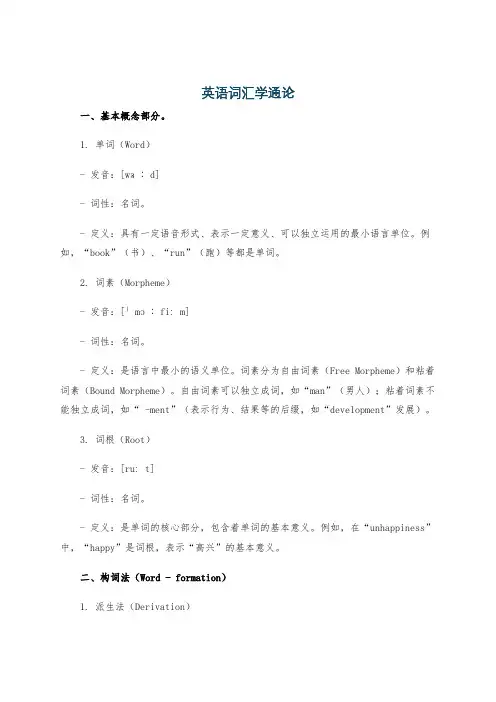
英语词汇学通论一、基本概念部分。
1. 单词(Word)- 发音:[wɜːd]- 词性:名词。
- 定义:具有一定语音形式、表示一定意义、可以独立运用的最小语言单位。
例如,“book”(书)、“run”(跑)等都是单词。
2. 词素(Morpheme)- 发音:[ˈmɔːfiːm]- 词性:名词。
- 定义:是语言中最小的语义单位。
词素分为自由词素(Free Morpheme)和粘着词素(Bound Morpheme)。
自由词素可以独立成词,如“man”(男人);粘着词素不能独立成词,如“ -ment”(表示行为、结果等的后缀,如“development”发展)。
3. 词根(Root)- 发音:[ruːt]- 词性:名词。
- 定义:是单词的核心部分,包含着单词的基本意义。
例如,在“unhappiness”中,“happy”是词根,表示“高兴”的基本意义。
二、构词法(Word - formation)1. 派生法(Derivation)- 发音:[ˌderɪˈveɪʃn]- 词性:名词。
- 解释:通过在词根上加前缀(Prefix)或后缀(Suffix)来构成新词的方法。
- 示例:- 加前缀:“un -”(表示否定) + “happy”(高兴的) = “unhappy”(不高兴的),“un -”的发音是[ʌn]。
- 加后缀:“teach”(教)+“ -er”(表示人) = “teacher”(教师),“ -er”的发音是[ə(r)]。
2. 合成法(Compounding)- 发音:[kəmˈpaʊndɪŋ]- 词性:名词。
- 解释:把两个或两个以上的词组合成一个新词的方法。
- 示例:- “black”(黑色的)+“board”(木板) = “blackboard”(黑板),“black”发音为[blæk],“board”发音为[bɔːd]。
- “day”(天)+“break”(打破,破晓) = “daybreak”(黎明),“day”发音为[deɪ],“break”发音为[breɪk]。
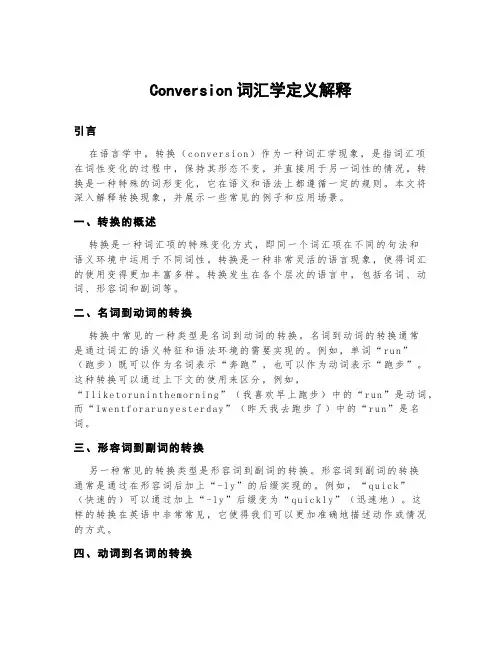
Conversion词汇学定义解释引言在语言学中,转换(c o nv er si on)作为一种词汇学现象,是指词汇项在词性变化的过程中,保持其形态不变,并直接用于另一词性的情况。
转换是一种特殊的词形变化,它在语义和语法上都遵循一定的规则。
本文将深入解释转换现象,并展示一些常见的例子和应用场景。
一、转换的概述转换是一种词汇项的特殊变化方式,即同一个词汇项在不同的句法和语义环境中运用于不同词性。
转换是一种非常灵活的语言现象,使得词汇的使用变得更加丰富多样。
转换发生在各个层次的语言中,包括名词、动词、形容词和副词等。
二、名词到动词的转换转换中常见的一种类型是名词到动词的转换。
名词到动词的转换通常是通过词汇的语义特征和语法环境的需要实现的。
例如,单词“r un”(跑步)既可以作为名词表示“奔跑”,也可以作为动词表示“跑步”。
这种转换可以通过上下文的使用来区分,例如,“I li ke to ru ni nt he m or ni ng”(我喜欢早上跑步)中的“r u n”是动词,而“Iw en tf or ar uny e st er da y”(昨天我去跑步了)中的“r u n”是名词。
三、形容词到副词的转换另一种常见的转换类型是形容词到副词的转换。
形容词到副词的转换通常是通过在形容词后加上“-l y”的后缀实现的。
例如,“q u ic k”(快速的)可以通过加上“-ly”后缀变为“qu ic kl y”(迅速地)。
这样的转换在英语中非常常见,它使得我们可以更加准确地描述动作或情况的方式。
四、动词到名词的转换除了名词到动词的转换外,动词到名词的转换也是一种常见的现象。
动词到名词的转换通常通过加上特定后缀实现,例如,“a rri v e”(到达)可以通过加上“-a l”后缀变为“a rr i va l”(到达)。
这种转换使得我们可以将动作或状态转化为一个名词,从而更好地描述或引用某种特定情况。
五、应用场景转换概念在日常语言中经常被使用,我们可以在各种语言环境和书面文本中找到转换的例子。

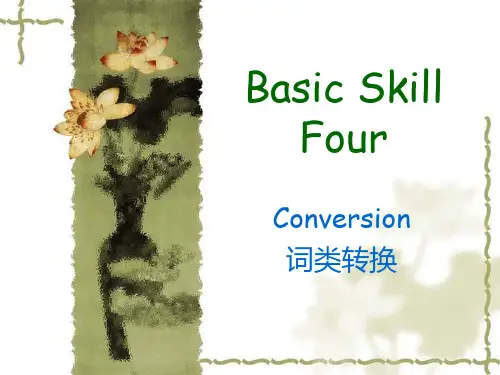
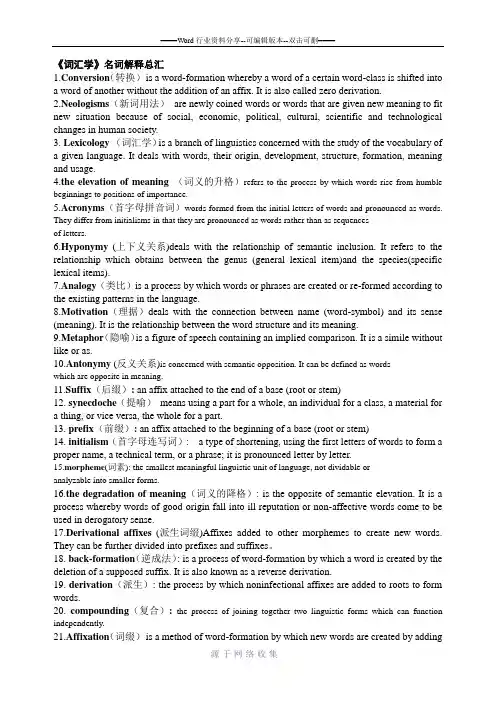
《词汇学》名词解释总汇1.Conversion(转换)is a word-formation whereby a word of a certain word-class is shifted intoa word of another without the addition of an affix. It is also called zero derivation.2.Neologisms(新词用法)are newly coined words or words that are given new meaning to fit new situation because of social, economic, political, cultural, scientific and technological changes in human society.3. Lexicology(词汇学)is a branch of linguistics concerned with the study of the vocabulary ofa given language. It deals with words, their origin, development, structure, formation, meaning and usage.4.the elevation of meaning(词义的升格)refers to the process by which words rise from humble beginnings to positions of importance.5.Acronyms(首字母拼音词)words formed from the initial letters of words and pronounced as words. They differ from initialisms in that they are pronounced as words rather than as sequencesof letters.6.Hyponymy(上下义关系)deals with the relationship of semantic inclusion. It refers to the relationship which obtains between the genus (general lexical item)and the species(specific lexical items).7.Analogy(类比)is a process by which words or phrases are created or re-formed according to the existing patterns in the language.8.Motivation(理据)deals with the connection between name (word-symbol) and its sense (meaning). It is the relationship between the word structure and its meaning.9.Metaphor(隐喻)is a figure of speech containing an implied comparison. It is a simile without like or as.10.Antonymy (反义关系)is concerned with semantic opposition. It can be defined as wordswhich are opposite in meaning.11.Suffix(后缀): an affix attached to the end of a base (root or stem)12. synecdoche(提喻)means using a part for a whole, an individual for a class, a material fora thing, or vice versa, the whole for a part.13. prefix(前缀): an affix attached to the beginning of a base (root or stem)14. initialism(首字母连写词): a type of shortening, using the first letters of words to form a proper name, a technical term, or a phrase; it is pronounced letter by letter.15.morpheme(词素): the smallest meaningful linguistic unit of language, not dividable oranalyzable into smaller forms.16.the degradation of meaning(词义的降格): is the opposite of semantic elevation. It is a process whereby words of good origin fall into ill reputation or non-affective words come to be used in derogatory sense.17.Derivational affixes(派生词缀)Affixes added to other morphemes to create new words. They can be further divided into prefixes and suffixes。


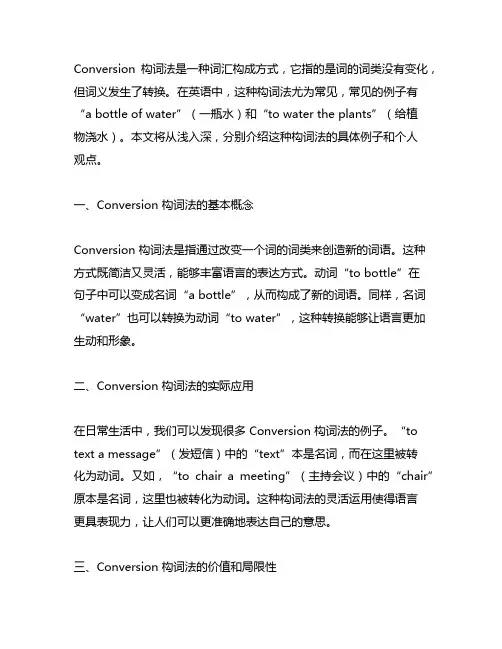
Conversion 构词法是一种词汇构成方式,它指的是词的词类没有变化,但词义发生了转换。
在英语中,这种构词法尤为常见,常见的例子有“a bottle of water”(一瓶水)和“to water the plants”(给植物浇水)。
本文将从浅入深,分别介绍这种构词法的具体例子和个人观点。
一、Conversion 构词法的基本概念Conversion 构词法是指通过改变一个词的词类来创造新的词语。
这种方式既简洁又灵活,能够丰富语言的表达方式。
动词“to bottle”在句子中可以变成名词“a bottle”,从而构成了新的词语。
同样,名词“water”也可以转换为动词“to water”,这种转换能够让语言更加生动和形象。
二、Conversion 构词法的实际应用在日常生活中,我们可以发现很多 Conversion 构词法的例子。
“to text a message”(发短信)中的“text”本是名词,而在这里被转化为动词。
又如,“to chair a meeting”(主持会议)中的“chair”原本是名词,这里也被转化为动词。
这种构词法的灵活运用使得语言更具表现力,让人们可以更准确地表达自己的意思。
三、Conversion 构词法的价值和局限性对于语言本身而言,Conversion 构词法能够让词汇更富有多样性,帮助人们更好地传达信息。
然而,这种构词法也存在一定的局限性,因为有些词转换后会产生歧义或造成困惑。
“to bottle the sauce”(把酱料装瓶)和“to sauce the bottle”(上酱料于瓶子)就会产生不同的意思,因此在运用 Conversion 构词法时需要谨慎选择。
四、对 Conversion 构词法的个人理解个人而言,我认为 Conversion 构词法的灵活性和多样性使得英语这一语言变得更加有趣。
通过转换词类,我们可以创造出更多新的词汇,让表达更加生动。


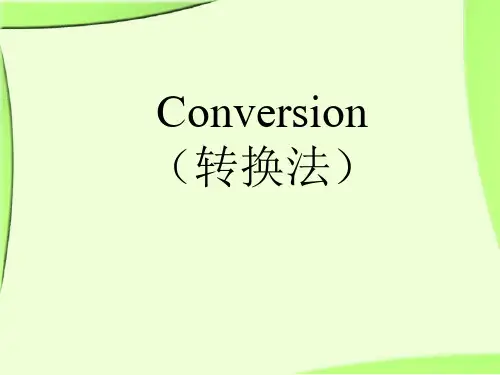
conversion构词法
conversion构词法是指将有许多单词,会指定每个单词的头音字母,在这些头音字母之间加上其他任意多的字母,以及其他任意多的词汇,来
组成一个新的单词。
这种构词法主要可以应用在相同属性的单词之间的转换,如把“bingo”构词为“binky”。
Converon构词法有三种基本的方法:
第一种方法就是在已有单词的头音字母之间加入新字母。
这种构词法
最常用于使用原有单词的头音字母进行快速构造新单词,比如将“bingo”构词为“binky”。
第二种方法是把原有单词的头音字母后加上一些其他单词或者短语,
以生成新单词,如将“bingo”构词为“bingomat”。
第三种方法是将两个或多个原有单词结合起来构成新单词,比如将“bingo”和“bingo”结合起来构成“bingonado”。
Conversion构词法的应用非常广泛,在英语中的构词方式已经普及
得非常广泛,可以大大简化英语的学习,帮助学生更加快捷地构造新的单词,又不需要去细记每一个单词的拼写。
Conversion
1.Definition of Conversion
Conversion / Functional shift/ Transmutation (转化法/功能转换法/转移法)is the word-formation by converting words of one class into another class (part of speech) without adding any affix.
It is also called derivation by zero suffix (零位后缀派生法) zero derivation(零位派生法).
2.Features of Conversion (P29)
3.Types of Conversion
1)Conversion to Verbs
De-nominal (nouns →verbs) (7 types)
De-adjective (adjectives →verbs) : To make…/to become…
2)Conversion to Nouns
De-verbal (verbs → nouns ) (5 types)
De-adjective (adjectives →nouns)
Full conversion: both as nouns and adjectives
Partial conversion: the+adj.
Miscellaneous
3)Conversion to Adjectives:
Nouns as attributives and predicatives
Miscellaneous
给大家推荐一个英语微信群-Empty Your Cup
英语微信群是目前学习英语最有效的方法,群里都是说英语,没有半个中文,而且规则非常严格,是一个超级不错的英语学习环境,群里有好多英语超好的超牛逼的人,还有鬼佬和外国美眉。
其实坦白说,如果自己一个人学习英语太孤独,太寂寞,没有办法坚持,好几次都会半途而废。
只要你加入到那个群里以后,自己就会每天都能在群里坚持学,坚持不停地说和练,由于是付费群,群里的成员学习氛围非常强,每天的训练度都非常猛,本来很懒惰的你一下子就被感染了,不由自主地被带动起来参与操练,不好意思偷懒,别人的刻苦学习精神会不知不觉影响你,Empty Your Cup英语微信群(进群加喂新 601332975)可以彻底治好你的拖延症,里面学员都非常友好,总是给你不断的帮助和鼓励,让你在学英语的路上重新燃起了斗志,因为每天都在运用,你的英语口语就能得到了迅猛的提升,现在可以随便给一个话题,都能用英文滔滔不绝的发表5分钟以上对这个话题的看法和观点,想提高英语口语的 可以加入进来,It really works very well.。